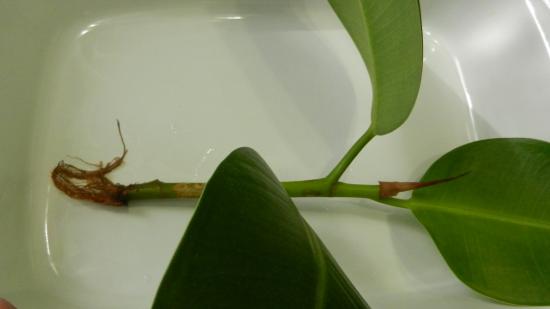Ficus rubber plant: caring for the plant at home

Rubber-bearing ficus has long been loved by flower growers in our country. If you pay attention, you will realize that it grows in the homes of many of your friends and family. The reason for such love is clear: the flower looks great, has large shiny leaves that are filled with juice. In some varieties of ficus they have a rich dark green color. Others have a lighter color, in some cases the leaf is edged with yellow.
Another reason why this ficus is so loved is that it is absolutely unpretentious in care, rarely gets sick, and does not require special attention. But, in order for a flower to grow healthy and delight you with its appearance, you need to know a few secrets of caring for it.
Content:
- How to propagate and replant a flower?
- Features of ficus care
- How to properly transplant rubber ficus?
How to propagate and replant a flower?
Rubber-bearing ficus can reproduce in two ways: using layering and cuttings. So, if you want to get a second ficus that would closely resemble the first, you need to use the layering method. But you can also use the cutting method. In order for it to give roots, you need to lower it into a container of warm water.
This must be done as quickly as possible, otherwise the root may simply rot. In order to transplant a flower, you need to use a scheme that is familiar to all lovers of growing flowers on a windowsill.
Young plants need to be replanted into a larger pot once a year, and an adult plant once every 2 or even 3 years. In this case, special attention should be paid to the root system. If you are replanting a young plant, it is better to use the following mixture for planting: 1 part river sand, 2 parts coniferous soil and 2 parts peat.
This mixture will help the plant adapt to the new pot as quickly as possible and saturate it with nutrients, vitamins and minerals for rapid growth. If you are replanting an already mature plant, then the mixture for planting should be as follows: in equal parts you need to mix humus, coniferous and leaf soil, turf soil and peat. This planting mixture will provide the flower with all the necessary minerals and the ficus will always look fresh and well-groomed.
Features of ficus care
There are some features of ficus care that you need to know about so that the plant is healthy and pleasing to the eye.
Speaking of watering, the rules that apply to other indoor flowers apply here. The ficus should be watered as the soil dries out. As soon as it becomes completely dry, moisten it for now. Watering produced with warm water, in small doses. At the same time, remember that pouring water from under the wound is unacceptable. Leave the water in some container for several days so that it settles and all the harmful substances settle to the bottom, and only then can you water the plant.
As for the temperature regime, the ficus is most afraid of drafts, so it should be placed in a place where there will be no gusts of wind or air. In summer, an excellent temperature for a flower will be 18-23 degrees. In winter, the temperature may remain the same, but you need to carefully monitor the level of moisture in the air.
If the air becomes dry (and this often happens due to heating devices), then the temperature can be reduced to 14 degrees by first insulating the soil of the pot with rags or foam plastic. In dry air, the leaves of the flower will become covered with yellow spots, and eventually it will simply die.

The flower also reacts well to various water treatments, this gives it freshness and bright color. You can wipe the leaves daily with a cloth soaked in warm water or spray them. But remember, the soil in the pot must be covered, otherwise it will absorb excess moisture, and this threatens to rot the root system of the flower.
There is one excellent piece of advice: in order to make the already shiny ficus leaves shine even brighter, you need to wipe them with a sponge dipped in non-alcoholic beer. This procedure should not be performed often, it is better only before the arrival of guests or holidays. Ficus does not like heat and bright constant light, so before buying this type of plant, think carefully about where you will place it and whether such conditions will suit it.
The flower will have enough daylight. At the same time, it is undesirable for it to be in direct sunlight. The best place is a window on the north side or a winter garden.
How to properly transplant rubber ficus?
It is recommended to replant young plants that are just developing and beginning to grow every year, but mature ficus plants once every 2-3 years, depending on how the roots fill the entire pot. The best time for transplantation is considered to be spring or summer. During this period, flowers best take root and restore their strength.
Video about proper transplantation and propagation of ficus:
You need to know a few tricks:
- You can understand that the soil in the pot is depleted and the plant needs to be replanted with water, which very quickly pours into the pan, practically not staying in the soil.
- At transplantation each next pot should be 5 cm larger in diameter than the previous one, and 5 cm deeper. This will allow the root system to grow and develop normally.
- But if the flower is already quite old, and you are worried that another transplant may completely destroy it, then just once a year, carefully remove the top layer of soil and apply a new substrate in its place.
In stores you can find ready-made soil intended for planting and replanting ficus trees. It is perfect for the plant. If you can’t find it, you can prepare the mixture yourself.
Sequence of plant transplantation:
- Pour 3-4 cm of new soil into the new pot.
- Carefully, so as not to damage the roots, remove the plant and transfer it, along with the lump of earth that remains on the roots, into a new pot.
- Fill the side voids with soil and sprinkle fresh mixture on top.
- After transplanting, you need to water the plant moderately and create favorable growth conditions for it.

If you follow all the rules and instructions, the flower will quickly adapt to the new pot and its growth will increase. Care Caring for the rubber ficus is not at all difficult, but it will always thank you for your care with beautiful large leaves that simply amaze with their juiciness. The flower will give a charge of positive emotions, especially in winter, thanks to its bright, saturated color.










